With millions of Americans on the road this Fourth of July holiday weekend, a new study shows the massive economic impact of our country’s national parks on largely rural gateway communities is even bigger than previously documented.
According to the National Park Service’s 2021 National Park Visitor Spending Effects study, over 297 million visitors spent $20.5 billion in communities within 60 miles of a national park in 2021.

“Nature is essential to the health, well-being, and prosperity of every family and community in America, as well as to the local economies of gateway communities that support our national parks,” said Secretary of the Interior Deb Haaland.
Of the 322,600 jobs supported by visitor spending, 268,900 jobs were in park gateway communities.
Spending by national park visitors in 2021 generated $14.6 billion in labor income and $24.3 billion in value-added for the lodging industry, with $7 billion in economic output directly contributing to this sector nationally as a result of their spending (directly influencing).
The restaurant sector saw the next greatest effects, with $4.2 billion in economic output directly contributing to this sector nationally, according to the report.
This year, The National Park Service is initiating a new socioeconomic monitoring project that will survey park visitors in 24 parks each year for the next 10 years or more.
The new, more in-depth methodology demonstrates that previous economic models underestimated the time visitors spent in the park and surrounding communities
“Zion National Park was one of the first parks where visitors were surveyed under the new method. The results showed that our previous estimates or ‘profiles’ of average visitors underestimated the time they spent in the park and in gateway communities and we underestimated the amount of money they spent during their trips to the park,” said National Park Service Director Chuck Sams.
Along with the report, a new interactive tool allows users to examine visitor spending, employment, labor income, value-added, and output effects by sector for national, state, and local economies. Users can also see year-by-year trend data.

“The new survey information will enable park managers to further improve the visitor experience and guide how to reach and engage with people who have yet to visit a national park,” he said.
The Great Smoky Mountains National Park topped the list of parks with the biggest economic benefit. As the most visited national park in the United States, with over 14 million visitors annually, the park anchors a large tourism industry based in Sevier County, Tennessee generating nearly $2 billion in economic output through 18,000 jobs.
The Blue Ridge Parkway—a National Parkway which includes America’s longest linear park, through 29 Virginia and North Carolina counties, linking Shenandoah National Park to the Great Smoky Mountains National Park—saw 15 million visitors in 2021. The tourism activity generated over $1.6 billion in local economic output and created over 17,000 jobs.
“National parks are a vital part of our nation’s economy, said White Sands Superintendent Marie Sauter whose national park generated over 600 jobs in rural New Mexico. “Especially for park gateway communities where millions of visitors each year find a place to sleep and eat, hire outfitters and guides and make use of other local services that help drive a vibrant tourism and outdoor recreation industry.”
“As we continue to welcome families to our parks and public lands across the country, the Interior Department is committed to making investments in our lands and waters that will support tens of thousands of jobs, safeguard the environment, and help ensure that national parks and public lands are ready to meet the challenges of climate change and increased visitation, Haaland said.
